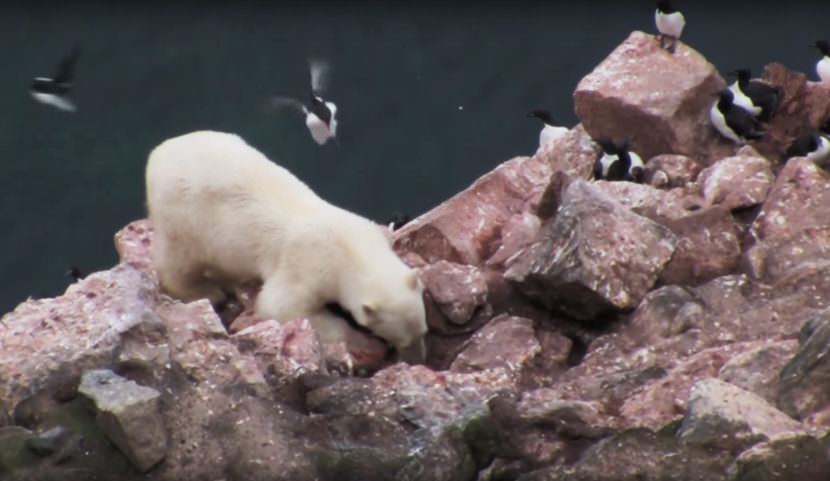
The latest research shows that diminishing Arctic sea ice caused by climate change is forcing some species to travel further to find food or look for alternative food sources.
“Polar bears are even showing up on murre colonies. Now, these are cliff-nesting birds,” Kathy Kuletz said. She’s a bird researcher with the U.S. Fish and Wildlife Service, referring to one notable example.
Kuletz’s research is part of a new report on Arctic marine biodiversity published by the Arctic Council in conjunction with their ministerial meeting in Fairbanks May 10-11. It describes how melting of the Arctic sea ice also is forcing marine species to shift their ranges further north. It also notes that increasing numbers of southern species are moving into Arctic waters, and it describes an increasing frequency in contagious diseases like avian cholera.
In a video version of the report produced by the Arctic Council, Haakon Hop of the Norwegian Polar Institute said the rapid reduction of thicker multi-year and second-year ice is having a dramatic impact on the Arctic sea ice ecosystem.
“Things are happening very fast. I don’t think most people realize how fast climate warming is affecting Arctic sea ice and the sea ice ecosystem,” Hop said. “I never thought I would see it in my quite short lifetime as a researcher. But I think I will see an ice-free Arctic Ocean before I’m done with my research career.”
Reduction in sea ice means changes for beluga whale migration. It also creates problems for harp seals, bearded seals and ringed seals when they have their pups or try to raise them. Walrus will haul out on shore rather than on sea ice, increasing calf mortality from possible stampedes and forcing adults to travel further to find food.
Kit Kovacs of the Norwegian Polar Institute remembers how the sea ice around the Svalbard Archipelago is dramatically different from just 12 years ago.
“Just suddenly, unpredicted, unprecedented collapse in sea ice,” Kovacs said. “And, it really hasn’t recovered.”
The absence of sea ice has affected how scientists observe or survey various species.
“We’re seeing profound changes, many of which are quite difficult to document because the traditional tools available to us like flying surveys at molting to count seals on sea ice are obviously no longer possible without sea ice,” Kovacs said.
Kovacs said they’re observing behavioral changes. Seals, for example, have to travel further to find food, dive deeper and for a longer period of time, and are resting less.
“All of which means, of course, it costs much more to get the food that you require,” Kovacs said. “That will eventually have reproductive consequences and growth consequences for these animals. You see that kind of phenomenon in many different species right now.”
Polar bears usually hunt seals on the sea ice.
But Kathy Kuletz of the U.S. Fish and Wildlife Service said polar bears have been observed foraging for food by going after ground-nesting common eiders or cliff-nesting murres.
“When the bears show up, they disturb the birds, the birds fly off,” Kuletz said. “That not only means that the bears are going after the chicks and eggs that they can get on the cliffs, but when the adult birds leave, because they’ve been startled by the bear, the other predators like gulls will come in and attack the eggs and chicks. It’s not just what the bears eat, but the disruption in the colony, as well.”
Connie Lovejoy of Quebec’s Université Laval said they can no longer take data from a particular event and extrapolate to the entire Arctic. For example, higher ocean temperatures may prompt an increase in small, warm water plankton called copepods in one region of the Arctic and an increase of fattier, cold water copepods on the opposite side of the Arctic.
“My big worry is really that by simplifying the system and not having enough data, those nuances, those small differences regionally, they’re lost,” Lovejoy said. “If you want to have local communities able to exploit their resources in the Arctic, they actually need to have a more accurate picture of what the future of their region is going to look like because there is no one Arctic.”
While some countries continuously monitor certain species, other countries may only do research that coincides with specific, short-term projects.
The 200-page report on Arctic marine biodiversity was produced by the Arctic Council’s Conservation of Arctic Flora and Fauna working group. It incorporates the work of 60 scientists from around the world, including three researchers from the University of Alaska Fairbanks.
Matt Miller is a reporter at KTOO in Juneau.




